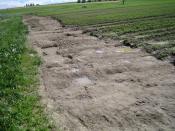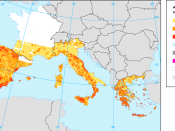Soil Erosion
Introduction
The term soil erosion generally means the destruction of soil by the action of wind and water. Some authors have modified this definition to include damage that is caused as a result of human actions. (D. Zachar p. 22)
Soil erosion causes a lot of damage. Apart from environmental damage involved, the financial losses associated with soil erosion are immense. For instance, America loses between $30 billion and $44 billion to soil erosion annually (Pimental et al 1993), whereas The United Kingdom also loses about ã90 million (Environment Agency 1989).
The purpose of this study is to examine the causes of soil erosion, its effects on the environment and the solutions available to control it, for the purpose of academic study.
The Causes of Soil Erosion
Soil erosion is mostly caused by climatic factors. They include rainfall and wind as the major factors. Other factors that contribute to soil erosion are mostly caused by human activities.
Such activities include mining, urbanization and vegetative clearing. The topography of the land also contributes to soil erosion.
Rainfall intensity contributes greatly to soil erosion. It is usually the main agent of erosion. The amount of intensity influences the magnitude of the erosion. It is the most critical factor. The greater the intensity of the rainstorm, the greater the runoff and consequently, soil erosion. (Blanco, Lal p 29).
Vegetative clearing is another factor that contributes to soil erosion. It is estimated that about 1 million hectares were cleared from the year 2000 to 2010. (SOE 2011 Report). Vegetation has a great role in preventing soil erosion. It reduces the destructive energy of rain by increasing the soil roughness. This is effective in slowing the runoff velocity. The vegetation also filters the soil particles in the runoff thus preventing further erosion. With...


